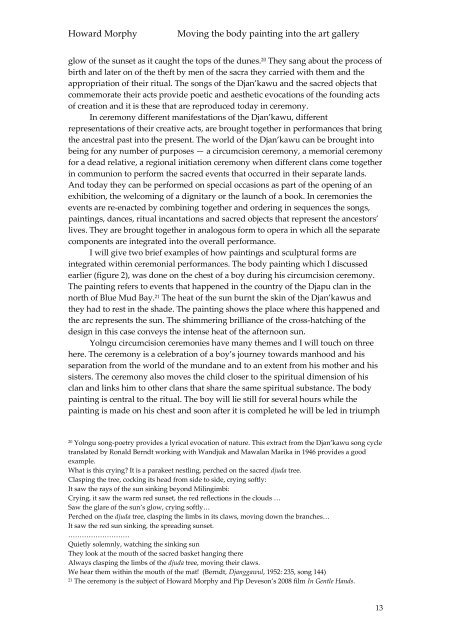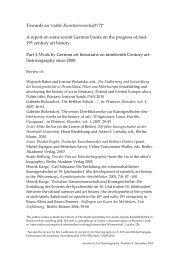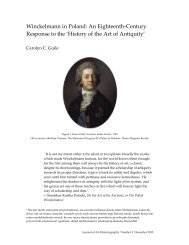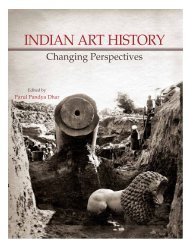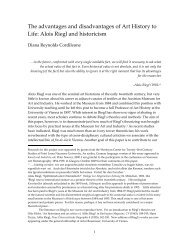Moving the body painting into the art gallery - Journal of Art ...
Moving the body painting into the art gallery - Journal of Art ...
Moving the body painting into the art gallery - Journal of Art ...
Create successful ePaper yourself
Turn your PDF publications into a flip-book with our unique Google optimized e-Paper software.
Howard Morphy <strong>Moving</strong> <strong>the</strong> <strong>body</strong> <strong>painting</strong> <strong>into</strong> <strong>the</strong> <strong>art</strong> <strong>gallery</strong><br />
glow <strong>of</strong> <strong>the</strong> sunset as it caught <strong>the</strong> tops <strong>of</strong> <strong>the</strong> dunes. 20 They sang about <strong>the</strong> process <strong>of</strong><br />
birth and later on <strong>of</strong> <strong>the</strong> <strong>the</strong>ft by men <strong>of</strong> <strong>the</strong> sacra <strong>the</strong>y carried with <strong>the</strong>m and <strong>the</strong><br />
appropriation <strong>of</strong> <strong>the</strong>ir ritual. The songs <strong>of</strong> <strong>the</strong> Djan’kawu and <strong>the</strong> sacred objects that<br />
commemorate <strong>the</strong>ir acts provide poetic and aes<strong>the</strong>tic evocations <strong>of</strong> <strong>the</strong> founding acts<br />
<strong>of</strong> creation and it is <strong>the</strong>se that are reproduced today in ceremony.<br />
In ceremony different manifestations <strong>of</strong> <strong>the</strong> Djan’kawu, different<br />
representations <strong>of</strong> <strong>the</strong>ir creative acts, are brought toge<strong>the</strong>r in performances that bring<br />
<strong>the</strong> ancestral past <strong>into</strong> <strong>the</strong> present. The world <strong>of</strong> <strong>the</strong> Djan’kawu can be brought <strong>into</strong><br />
being for any number <strong>of</strong> purposes — a circumcision ceremony, a memorial ceremony<br />
for a dead relative, a regional initiation ceremony when different clans come toge<strong>the</strong>r<br />
in communion to perform <strong>the</strong> sacred events that occurred in <strong>the</strong>ir separate lands.<br />
And today <strong>the</strong>y can be performed on special occasions as p<strong>art</strong> <strong>of</strong> <strong>the</strong> opening <strong>of</strong> an<br />
exhibition, <strong>the</strong> welcoming <strong>of</strong> a dignitary or <strong>the</strong> launch <strong>of</strong> a book. In ceremonies <strong>the</strong><br />
events are re-enacted by combining toge<strong>the</strong>r and ordering in sequences <strong>the</strong> songs,<br />
<strong>painting</strong>s, dances, ritual incantations and sacred objects that represent <strong>the</strong> ancestors’<br />
lives. They are brought toge<strong>the</strong>r in analogous form to opera in which all <strong>the</strong> separate<br />
components are integrated <strong>into</strong> <strong>the</strong> overall performance.<br />
I will give two brief examples <strong>of</strong> how <strong>painting</strong>s and sculptural forms are<br />
integrated within ceremonial performances. The <strong>body</strong> <strong>painting</strong> which I discussed<br />
earlier (figure 2), was done on <strong>the</strong> chest <strong>of</strong> a boy during his circumcision ceremony.<br />
The <strong>painting</strong> refers to events that happened in <strong>the</strong> country <strong>of</strong> <strong>the</strong> Djapu clan in <strong>the</strong><br />
north <strong>of</strong> Blue Mud Bay. 21 The heat <strong>of</strong> <strong>the</strong> sun burnt <strong>the</strong> skin <strong>of</strong> <strong>the</strong> Djan’kawus and<br />
<strong>the</strong>y had to rest in <strong>the</strong> shade. The <strong>painting</strong> shows <strong>the</strong> place where this happened and<br />
<strong>the</strong> arc represents <strong>the</strong> sun. The shimmering brilliance <strong>of</strong> <strong>the</strong> cross-hatching <strong>of</strong> <strong>the</strong><br />
design in this case conveys <strong>the</strong> intense heat <strong>of</strong> <strong>the</strong> afternoon sun.<br />
Yolngu circumcision ceremonies have many <strong>the</strong>mes and I will touch on three<br />
here. The ceremony is a celebration <strong>of</strong> a boy’s journey towards manhood and his<br />
separation from <strong>the</strong> world <strong>of</strong> <strong>the</strong> mundane and to an extent from his mo<strong>the</strong>r and his<br />
sisters. The ceremony also moves <strong>the</strong> child closer to <strong>the</strong> spiritual dimension <strong>of</strong> his<br />
clan and links him to o<strong>the</strong>r clans that share <strong>the</strong> same spiritual substance. The <strong>body</strong><br />
<strong>painting</strong> is central to <strong>the</strong> ritual. The boy will lie still for several hours while <strong>the</strong><br />
<strong>painting</strong> is made on his chest and soon after it is completed he will be led in triumph<br />
20 Yolngu song-poetry provides a lyrical evocation <strong>of</strong> nature. This extract from <strong>the</strong> Djan’kawu song cycle<br />
translated by Ronald Berndt working with Wandjuk and Mawalan Marika in 1946 provides a good<br />
example.<br />
What is this crying? It is a parakeet nestling, perched on <strong>the</strong> sacred djuda tree.<br />
Clasping <strong>the</strong> tree, cocking its head from side to side, crying s<strong>of</strong>tly:<br />
It saw <strong>the</strong> rays <strong>of</strong> <strong>the</strong> sun sinking beyond Milingimbi:<br />
Crying, it saw <strong>the</strong> warm red sunset, <strong>the</strong> red reflections in <strong>the</strong> clouds …<br />
Saw <strong>the</strong> glare <strong>of</strong> <strong>the</strong> sun’s glow, crying s<strong>of</strong>tly…<br />
Perched on <strong>the</strong> djuda tree, clasping <strong>the</strong> limbs in its claws, moving down <strong>the</strong> branches…<br />
It saw <strong>the</strong> red sun sinking, <strong>the</strong> spreading sunset.<br />
………………………<br />
Quietly solemnly, watching <strong>the</strong> sinking sun<br />
They look at <strong>the</strong> mouth <strong>of</strong> <strong>the</strong> sacred basket hanging <strong>the</strong>re<br />
Always clasping <strong>the</strong> limbs <strong>of</strong> <strong>the</strong> djuda tree, moving <strong>the</strong>ir claws.<br />
We hear <strong>the</strong>m within <strong>the</strong> mouth <strong>of</strong> <strong>the</strong> mat! (Berndt, Djanggawul, 1952: 235, song 144)<br />
21 The ceremony is <strong>the</strong> subject <strong>of</strong> Howard Morphy and Pip Deveson’s 2008 film In Gentle Hands.<br />
13


